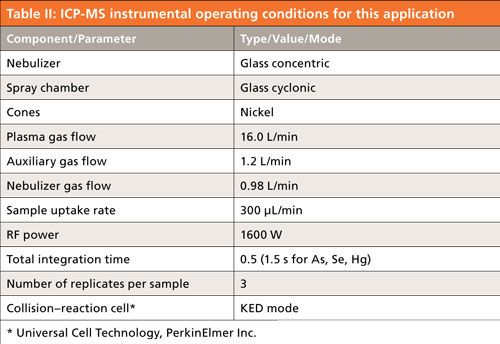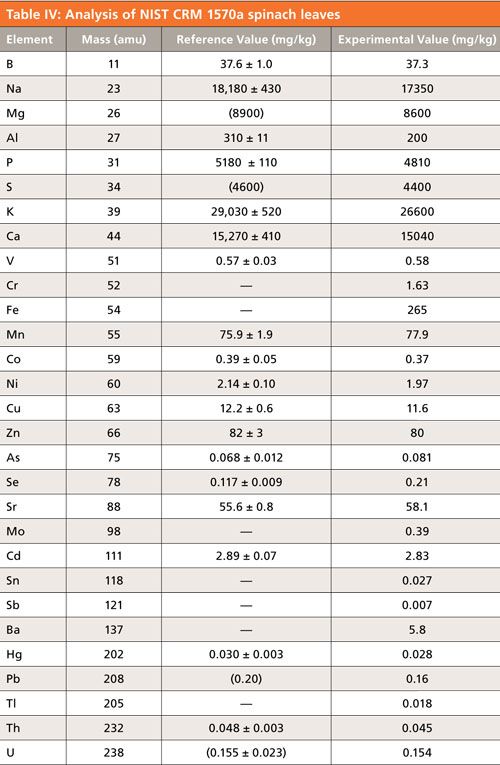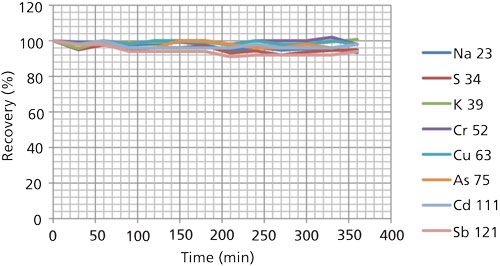The Benefits of ICP-MS for the Determination of Toxic and Nutritional Elements in the Cannabis Family of Flowering Plants
Special Issues
The wide dynamic range of ICP-MS allows it to be used for the simultaneous determination of parts-per-billion levels of heavy metals including lead, arsenic, cadmium, and mercury, together with high parts-per-million levels of nutritional elements, such as phosphorus, calcium, potassium, and magnesium.
This study focuses on an inductively coupled plasma–mass spectrometry (ICP-MS) sample preparation procedure and analytical methodology optimized for both toxic and nutritional elements in dried hops, a surrogate for the cannabis family of flowering plants. It shows that the wide dynamic range of the technique allows it to be used for the simultaneous determination of parts-per-billion levels of heavy metals including Pb, As, Cd, and Hg, together with high parts-per-million levels of nutritional elements, such as P, Ca, K, and Mg.
More than half of the states in the United States now allow for some form of legal use of cannabis in its various forms, including marijuana products and hemp. Its use as a medicine has been allowed in Colorado, Washington, California, Maine, Massachusetts, and Nevada for a number of years, and even traditionally conservative states like Arkansas, Florida, Montana, and North Dakota have recently enacted policy, enabling it be used for medical purposes. As a result of the widespread use of cannabis, there is not only a growing need for high-quality analytical testing of its potency, but also to assess its purity and level of contaminants (1).
One of the main areas of concern is the level of heavy metals and other elemental impurities in the cannabis plant. Metals such as arsenic, lead, cadmium, mercury, nickel, copper chromium, and aluminum can all be present in the cannabis plant because of uptake from the soil, from the use of fertilizers or hydroponic media used to enhance the growth of the plant, or possibly due to environmental pollution from industrial fallout. In addition, cannabis plants are also very efficient at extracting and accumulating metals from their environment and as a result have historically been used to clean up contaminants from toxic waste sites (2).
Cannabis growers with laboratory capabilities, who are authorized to analyze cannabinoids, can easily gain access to samples for testing purposes. However, other researchers who want to carry out scientific studies on the level of contaminants in cannabis cannot legally obtain these types of samples. Fortunately, cannabis, and humulus (hops used to make beer) belong to the same small family of flowering plants called cannabaceae. For that reason, hops are a generally accepted surrogate for cannabis because of its similar chemical and physical properties (3).
Therefore, this study focuses on a sample preparation procedure and analytical methodology optimized for both toxic elements at low parts-per-billion (ppb) levels and high concentrations of macro elements at parts-per-million (ppm) levels in dried hop samples by inductively coupled plasma–mass spectrometry (ICP-MS).
Discussion
The working range of ICP-MS makes it ideally suited for the analysis of plant materials. The ultratrace detection limits of ICP-MS permit the determination of low-level contaminants such as Pb, As, Se, and Hg, while the macro-level nutritional elements such as Ca, Mg, K, and Na can be quantified using the extended dynamic range capability of the technique, which provides up to 10–11 orders of magnitude. However, there are still a number of challenges to overcome, which makes the routine analysis of plant matrices difficult unless the sample dissolution procedure is well thought out and instrumental conditions are optimized for complex sample matrices. For example, plant matrices contain high levels of organic components which when digested can pose major problems for any ICP-MS because of the potential for blocking of the interface cones or deposition on the ion optics. For this reason, if the instrument design is not optimized for high-matrix samples, long-term stability can be severely compromised.
In addition to signal drift, the sample’s organic components, together with macro minerals, can combine with elements present in the digestion acid or the plasma argon to form polyatomic interferences. For example, chloride ions (at mass 35) combine with the major argon isotope (mass 40) to produce the argon chloride interference 40Ar35Cl+, which interferes with arsenic at mass 75. Another example is the argon dimer (40Ar40Ar+), which forms from the plasma gas and exists at the same masses as the major selenium isotopes. In addition, the major isotope of chromium at mass 52 is overlapped by 40Ar12C+, 35Cl17O+, and 35Cl16OH+ interferences generated by the sample matrix and the plasma gas. As a result, these kinds of spectral interferences have made the determination of both trace and macro elements in plant digest samples extremely challenging, unless the system is fitted with collision-reaction cell capability, which can reduce the impact of these interferences.
Experimental
Sample Preparation
Hops were purchased from a commercial store and chopped into small pieces, both to homogenize the sample and expose more surface area for increased digestion efficiency. A microwave sample preparation system (Titan MPS, PerkinElmer Inc.) using standard 75 mL polytetrafluoroethylene (PTFE) vessels was used for digestion, following the program shown in Table I.

Each vessel contained 0.25 g of plant material, 5.0 mL of concentrated nitric acid, 5.0 mL water, and 3.0 mL of 30% hydrogen peroxide. After digestion, the samples were diluted to 50 mL with deionized water, along with the addition of gold (Au) equivalent to 200 μg/L Au in the final solution, to stabilize the mercury.
Instrumental Conditions
All analyses were performed on a NexION 300/350 ICP-MS system (Perkin-Elmer Inc.) with the standard sample introduction system of a concentric nebulizer and a cyclonic spray chamber. The full instrumental operating conditions for this investigation are shown in Table II.

The elements chosen for the investigation, analytical masses, and universal cell conditions used are shown in Table II. It should be emphasized that the benefits of collision–reaction cell technology are well documented (4). However, the capability to switch between collision, reaction, and standard modes is critically important for a large suite of elements, particularly when spectral complexity varies based on the analyte mass used and different combinations of matrix, solvent, and argon ions encountered. For this suite of 30 elements, the method development process identified a group that required collision mode (kinetic energy discrimination [KED] mode using helium gas) and a group that required standard mode conditions. Table III identifies the analyte masses, together with the choice of collision-reaction cell modes used.

Calibration
Multielement calibration standards, representing all of the analytes of interest, were made up from PerkinElmer Pure single and multielement standards and diluted into 10% HNO3. As with the samples, gold was added to all solutions at a final concentration of 200 μg/L to stabilize mercury. Calibration standard ranges were based on whether the analyte was expected to be a high-level, nutritional element like potassium (K), a low-level essential element like iron (Fe), or an ultratrace contaminant such as arsenic (As). As a result, three different calibration ranges were made up to cover the complete suite of elements being determined:
- High-level nutritional analytes: 0–300 ppm
- Low-level essential analytes: 0–2 ppm
- Ultratrace-level contaminants: 0–20 ppb
It should also be noted that these are concentrations introduced into the instrument, but represented a 200-fold dilution based on the sample preparation procedure of 0.25 g in 50 mL. Additionally, the following internal standards were used to cover the full suite of analyte masses: 10 mg/L 45Sc, 5 mg/L 72Ge, and 0.1 mg/L 103Rh, 115In, 159Tb in 10% methanol and 1% nitric acid, which were added on-line via a mixing tee to all blanks, standards, and samples.
Results
In a separate study, to show how the potential problem areas previously outlined could be minimized, six National Institute of Standards and Technology (NIST) food or plant-based standard reference materials (SRMs) (corn bran, bovine muscle, mussel tissue, milk powder, wheat flour, and spinach leaves) were analyzed using similar sample preparation and analytical conditions to assess the accuracy of this methodology (5). These data are exemplified in Table IV, which shows the determination of a large suite of elements in one of the certified reference materials (CRMs), “NIST 1570a Spinach Leaves.” The experimental data show very good agreement with the certified values, especially for the elements that suffer from known spectral interferences. The elements that are outside the specified limits are mostly the ones that are well recognized as environmental contami-nants, which were most likely impacted by the sample preparation procedure. Note: The figures in parentheses in the reference value column are not certified values, but are included for information purposes only.

To emphasize the long-term drift capability of the instrument, the six NIST SRM samples were run for 6 h continuously, while a quality control (QC) standard was read every five samples. Figure 1 shows the long-term stability of a selected group of high-level, low-level, and ultratrace-level analytes in the QC standard. On further examination, the data shows recoveries of 91–103% over the 6 h.
Figure 1: Percent recovery of several analytes in the QC sample during 6 h of analysis.

Once the method had been validated with the NIST SRMs, the analysis of two separate digestions of the hop samples were carried out. The average results are shown in Table V. In addition, to evaluate the accuracy, predigestion samples were spiked for those elements present at less than 50 mg/kg. The spike levels were 20 mg/L for all elements, except Hg, which was spiked at 2 mg/L. All spike recoveries were within 15% of the added amounts, further validating the methodology.

Conclusions
This work has demonstrated the ability of ICP-MS, combined with microwave sample digestion to effectively analyze hop samples (as a surrogate for cannabis) for both nutritional elements at high milligram-per-kilogram (ppm) levels and trace elemental contaminants at microgram-per-kilogram (ppb) levels in the original matrix, without having to carry out further sample dilutions. Analyses were optimized using a combination of collision cell and standard modes, which required only 100 s per sample total analysis time. The drift characteristics of the applied method was further assessed by running QC check standards and plant or food-based materials over 6 h. The accuracy was validated by analyzing a NIST spinach leaf CRM.
References
- M.A. Branca, Chem. Eng. News94(36), http://cen.acs.org/cannabis-analysis-takes-off.html (2016).
- “Heavy Metals and Cannabis: What You Don’t See Can Hurt You,” United Patients Group, April 6, 2015, https://unitedpatientsgroup.com/blog/2015/04/06/heavy-metals-and-cannabis-what-you-dont-see-can-hurt-you.
- C. Borbone, J. Yu, and N. Zabe, “Cannabis, Hemp, and Hops: Sample Comparative Results with Qualitative Strip Test Analysis for the Determination of Total Aflatoxin,” presented at the Cannabis Extraction and Analytics Poster Session at the 107th AOCS Annual Meeting & Expo, Salt Lake City, Utah, 2016.
- R. Thomas, Spectroscopy17(2), 42–48 (2002).
- C. Bosnak and E. Pruszkowski, “The Determination of Toxic, Essential, and Nutritional Elements in Food Matrices Using ICP-MS,” PerkinElmer Application Note, 2015, https://www.perkinelmer.com/pdfs/downloads/APP_FoodAnalysisbyNexIONICPMS.pdf.
Ewa Pruszkowski and Cynthia Bosnak are with PerkinElmer Inc., in Shelton, Connecticut. Direct correspondence to: ewa.pruszkowski@perkinelmer.com and cynthia.bosnak@perkinelmer.com

Evaluation of Modified QuEChERS for Pesticide Analysis in Cannabis
May 2nd 2017Well-established techniques used by the food safety industry, such as QuEChERS sample preparation followed by LC–MS/MS for the analysis of multiresidue pesticides, are evaluated for use with cannabis plant material.We evaluated a modified QuEChERS LC-MS/MS method for analysis of multiresidue pesticides.
Analysis of Terpenes in Cannabis Using Headspace Solid-Phase Microextraction and GC–MS
May 2nd 2017Headspace SPME combined with GC–MS for the qualitative and quantitative analysis of terpenes in cannabis offers several advantages compared to other methods. It does not require the use of organic solvents, does not coextract matrix, and provides additional means of peak identification and purity using spectral data. It is also a nondestructive method.